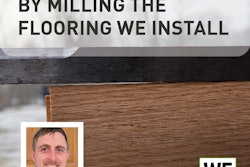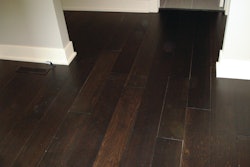The Problem
I received a call from a member manufacturer for a job-site inspection. They had a complaint about a floor that had been installed about a year earlier. Now the customer was noticing small holes in some boards, and a pest control company told her that she had powderpost beetles in her floor. The company recommended fumigating her house at a cost of several thousand dollars.
The Procedure
The floor was site-finished, No.1 common red oak strip installed over joists. The floor had been sanded, stained and coated with two coats of oilmodified polyurethane.
At the job site, I checked the moisture content levels of the boards indicated, which were 7 to 8 percent, well within the normal range. I also measured the boards, which were 2 1/4 inches wide, exactly as they should have been. In talking with the homeowner, I discovered that she had not seen any actual insects, and neither had the pest control expert, however, he looked at the holes and declared them to be powderpost beetle holes.
I looked for evidence of an active infestation. For powderpost beetles, there are several clues. The most obvious is spotting an actual live beetle. Powderpost beetles have a hard shell and measure from about 1/16 to 1/8 inch in length. When they emerge from the flooring, their holes are vertical to the face of the wood. An active infestation will have "frass," which is the telltale powder that accumulates around the hole. It has the consistency of talcum powder and looks like a little volcano surrounding the hole. In looking at the flooring in question, I couldn't find any insects or any frass, and I also noticed that most of the holes were not vertical to the face of the boards. Some finish and stain color extended down into some holes. In others, the entire walls of the holes were stained, which is usually evidence of ambrosia beetles. I determined that this was not an active insect infestation.
The Cause
The pest control person was correct in that insects had made the holes in question, however, these holes had not been made recently. In any case, the holes were grade characters that existed in the rough lumber. When the flooring is installed and sanded, existing holes are packed with sanding dust that is covered by the finish. As the floor expands and contracts, the dust collapses, and traffic on the floor causes the finish over the holes to break, exposing the holes for the first time.
How to Fix the Floor
Small holes such as those from powderpost beetles are acceptable in almost all grades of flooring. If the customer objects to seeing the holes in the floor, the typical solution is to use a filler designed for finished floors to fill the holes.
In the Future
With complaints regarding potential powderpost beetle infestations, the most important thing is to look for signs of an active infestation. If it is active, it's important to have the bug identified by a professional entomologist. Many pest control workers are not qualified to make a positive identification. If it appears that there is an active infestation but there aren't any obvious insects, one way to coax them out is to put a glass over the hole, wait until dark and shine a flashlight onto the glass. The light should attract the creatures up into the glass so they can be captured. If there is an active infestation of a few boards, usually replacing those boards will remove the bugs; if the infestation is larger, usually sanding and treating the floor with a borax treatment designed for powderpost beetle infestations will do the trick.

































